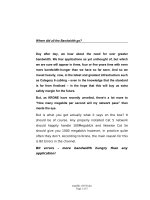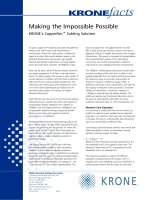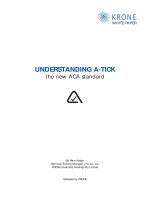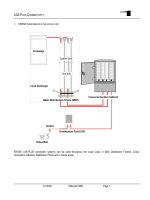Tài liệu KRONE - White paper - TrueNET - AirES_Mech_WP - 2002 doc
Bạn đang xem bản rút gọn của tài liệu. Xem và tải ngay bản đầy đủ của tài liệu tại đây (432.8 KB, 4 trang )
The AirES product range
of cables are a true
innovation in structured
cabling. In most evolu-
tionary processes the
gain in one attribute often
sacrifices another. With the AirES revolution
all attributes, both physical and electrical,
are improved to provide a “Win-Win” situation
for both the installer and customer.
This white paper will focus on the mechanical
attributes and advantages of AirES. Herein,
we will discuss the development of the technology
and the byproduct effects on any and all
mechanical parameters.
The industry migration to UTP cables in the
first place was a push to make the cabling
plant more cost effective and less obtrusive.
Since the days of Coax and Type 1 cables,
the industry has moved to reduce the size and
cost through the introduction of UTP cables.
Over several years the electrical performance of
UTP cables has increased dramatically. We’ve
migrated from Cat 3 cabling supporting 10BaseT
to Cat 5 supporting 100BaseTX and now our
progression has taken us not only to Cat 5e for
1000BaseT, but to a cabling standard designed
to meet the next technology wave in Cat 6.
The IEEE develops these advances in trans-
mission protocol and hands it off to the TIA to
develop the latest and greatest UTP cable
that can support the electrical requirements.
At the same time our market has become
more and more competitive. The price of
materials has dropped dramatically, as well
as the price of installation…or has it?
Installers now find that they need to install
cables more quickly than before to be com-
petitive. While at the same time the cables
have become more difficult to install! We
here at KRONE have been listening to our
installers and decided enough is enough.
It’s time to deliver a product whose electrical
performance is superior and at the same time
is actually easier to install.
Several attributes are taken into consideration
when pulling cable into an installation.
1. The raceways that will be used.
2. The access to drop locations.
3. Timeline for installation.
4. Fire codes.
5. Product set for both the Telecommunications
Closet and Workstation.
6. Testing of the product after the installation
is complete.
7. Warranty.
8. Reliability of brand for installer reputation.
The magic number 32:
The number of cables pulled simultaneously
makes for faster installation times. With AirES
cable the pulling tension has been reduced
by 32% on average. This means 32% more
cables can be pulled at the same time,
reducing installation time.
TrueNet
™
AirES
™
Technology
Mechanical Attributes
KRONE
™
HAS
DEVELOPED
YET ANOTHER
LEADING
TTEECCHHNNOOLLOOGGYY
The number of cables that can fit into the
space supplied has also dramatically increased.
Fill rates have gone up with AirES by an
average of 32% for C6T and 28% C5eT.
The example below is from the NEC fill rate
chart. We compared 5 of our leading competitors
equal Category cables against our own. They
ranged from a fill rate of 47 to 60 cables at a
40% fill rate in 3” conduit.
In both the Cat 5e and Cat 6 examples the fill
rate of the AirES cables were much greater
than that of all competitors. Typically the AirES
cable has a 28-32% advantage for C5eT and
C6T. On the left is a bundle of 24 AirES Cat 6
0.20” cables. On the right a bundle of 24
“Industry Standard” Cat 6 0.25” OD cables.
The above example is dramatic in showing the size
difference between the new and old style cables.
This is achieved through reducing the size of our pri-
mary conductor. The effect over a total of 8 conduc-
tors in a 4 pair UTP cable is dramatic.
What this means to the customer is more cables in
the same space or less space needed for the same
number of cables! A reduction in cable tray, conduit,
raceway, etc. For the installer this means less frus-
tration due to limited access space.
137
93
0
20
40
60
80
100
120
140
C5ET AIRES COMPETITOR AVERAGE
CAT 5E CABLE FILL 3" CONDUIT @ 40% TO NEC SPECIFICATIONS
CA
CABLE FILL 3” CONDUIT @40%
85
57
0
10
20
30
40
50
60
70
80
90
C6T AIRES COMPETITOR AVERAGE
CAT 6 CABLE FILL 3" CONDUIT @ 40% to NEC SPECIFICATIONS
CABLE FILL 3" CONDUIT @ 40%
AirES CONDUCTOR
INDUSTRY STANDARD
CONDUCTOR
AirES 4 pr. UTP Cable INDUSTRY STANDARD
4 pr. UTP Cable
From a safety prospective the AirES cable is better
than industry standard designs. We currently use
FEP insulation in the Plenum space to reduce the
risk of fire speed and intensity. With AirES the
amount of fuel is reduced by 32% through the intro-
duction of AIR.
The number of cables that can be pulled in at the
same time increases greatly for the installer. When
a cable is larger in diameter it is also heavier in
weight. The effect is an increased amount of force in
pulling tension to remove it from the box and an
increase in cross sectional area for friction during
the pull. The smaller bundle size also decreases the
surface area of the same number of cables vs. the
industry standard design, which allows for more
cables to be pulled at the same time.
Lets take a 1000 drop Cat 6 installation for example.
If the installer was to pull 6 cables simultaneously for
the entire installation there would be a total of 167
bundles for the site. With the AIRES Cat 6 design
32% more cables can be pulled in due to the
reduced pulling tension. Now we are pulling 8
cables in simultaneously. The job is now finished
with only 125 bundles pulled.
The amount of force needed to terminate has also
been greatly reduced due to the smaller conductor
size and the introduction of Air. On Cat 6 the reduc-
tion in force is even greater through the use of a
smaller conductor size and less insulation. This is
achieved through the increased electrical perform-
ance of the cable, which you can learn more about in
our "Electrical Characteristics of AirES" white paper.
In the example below an 11% reduction in force is
realized. This reduces the amount of fatigue experi-
enced by the installer during the termination phase
of the installation.
1.5
2.3
0
0.5
1
1.5
2
2.5
C6T AIRES COMPETITOR AVERAGE
AMOUNT OF FORCE NEEDED TO PULL ONE CAT 6 UTP CABLE
PULLING TENSION IN lb (reel in a box)
125
167
0
20
40
60
80
100
120
140
160
180
C6T AIRES COMPETITOR AVERAGE
EFFECT OF CABLE PULLING TENSION REDUCTION OF AIRES ON 1000 DROPS
BUNDLES NEEDED FOR 1000 DRO
77
87
0
10
20
30
40
50
60
70
80
90
C6T AIRES COMPETITOR AVERAGE
COMPARISON OF AIRES VS. COMETITOR AVERAGE
FORCE FOR INSERTION INTO A KRONE BLOCK 45¡ IDC
INSERTION FORCE IN N (USING A KRONE TOO
Through the use of a smaller conductor, fewer
twists, the reduced insulation size and the use of
a tape filler rather than a star for Cat 6, the time to
terminate is reduced as well. In the example below
there was an 18% time savings using AirES cable.
Through the reduction in cable size the overall
weight of a box of AirES cable is greatly reduced.
This now allows KRONE to put 2000’ of cable on a
standard 1000’ put up reel and stay below the 50lb
limit for lifting, set by OSHA. After each reel of cable
is complete there is a length of scrap left over.
Through the introduction of 2000’ put ups this is
reduced in half.
The ability of a cable to withstand the rigors of
installation must also be taken into account during
design. Too often for the sake of transmission per-
formance the cable becomes more fragile and sus-
ceptible to damage. Through the reduction in twist
lay variation in AirES the cable becomes less prone
to performance loss due to pulling tension, as the
effect of the different twist lays is not as critical. What
this means to the installer is fewer field issues to
investigate during the testing phase.
Structural integrity with regards to crush resistance
has not been compromised with the use of the
AirES design. The first question on everyone’s lips
after understanding how the AirES cable is designed
seems to involve its ability to resist crush. With other
designs that involve the foaming of insulation materi-
als to introduce air, crush has been a large problem.
Type 1 cables of old were able to withstand crush
due to each pair being individually shielded, but for
UTP applications the concerns are founded.
AirES through its arched air pocket construction
uses several solid insulation beams distributed
evenly around the conductor, coupled with the
arch shape of the pocket. The result is a total
cable exceeding the UL444 requirements for
crush resistance by >4X the requirement. Once
again eclipsing our nearest competitor.
UL444 Scope:
This standard applies to 60-250ku8C single- or mul-
tiple-conductor jacketed or unjacketed, integral or
nonintegral cables and single or multiple coaxial
cables for telephone and other communication cir-
cuits such as voice, data, and audio for on-premise
customer systems. These cables are not prohibited
from containing one or more optical fiber members.
For the purpose of this standard, a coaxial cable or
coaxial member conductor is single conductor with
a shield. For the purpose of this standard, a single-
or multiple-conductor unjacketed cable is a cross-
connect wire.
This standard applies to communications cable
intended primarily for installation in accordance
with Section 60 of the Canadian Electrical
Code (CEC), Part 1, and Article 800 of the
National Electrical Code (NEC). They are rated
for 300 V applications but are not so marked.
This standard does not apply to communication cords.
For more information regarding AirES and all other
KRONE products please contact the following:
Customer Support
1-800-775-KRONE (5766)
Sales Engineer near you
/>Author Bio
Tim Takala is the Director of Support Technologies for
KRONE Inc. Prior to joining the US team in 2000, he was
the Laboratory and Technical Manager for Asia/Pac, KRONE
Australia. Mr. Takala was instrumental in the development
and implementation of the technical methodologies behind
KRONE’s TrueNet
™
System and its warranty program, Mr.
Takala holds an Industrial Engineering degree from the
Sydney Institute of Technology.
90
110
0
20
40
60
80
100
120
C6T AIRES COMPETITOR AVERAGE
TERMINATION TIME IN SECONDS FOR A CAT 6 CABLE
AVERAGE TIME IN TO TERMINATE ON ULTIM8 BLOCK









